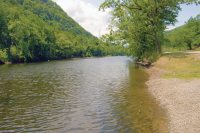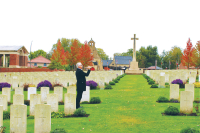A winter rescue: Rangers trek into frigid, snowy darkness to save hikers
 By 7:30 p.m. on Jan. 2, the sky had long gone dark and rain was turning to snow. It was the perfect night to watch a football game. But Steve Kloster had barely gotten past the kickoff of the Sugar Bowl showdown between the Alabama Crimson Tide and Oklahoma Sooners before a phone call tore him away from cheering for the Southeastern Conference powerhouse. Chief Ranger Clayton Jordan was on the line, calling the Tennessee District Ranger for the Great Smoky Mountains National Park into an even higher-stakes contest.
By 7:30 p.m. on Jan. 2, the sky had long gone dark and rain was turning to snow. It was the perfect night to watch a football game. But Steve Kloster had barely gotten past the kickoff of the Sugar Bowl showdown between the Alabama Crimson Tide and Oklahoma Sooners before a phone call tore him away from cheering for the Southeastern Conference powerhouse. Chief Ranger Clayton Jordan was on the line, calling the Tennessee District Ranger for the Great Smoky Mountains National Park into an even higher-stakes contest.
7:45 p.m.
“They told me they had a report of a significant incident at the Mollie’s Ridge shelter [on the Appalachian Trail],” Kloster said. “There was enough communication to know that they were not moving on the trail, that they had 60-degree sleeping bags, and in the background they could hear one of the guys say, ‘I can’t walk. I have frostbite.’”
The broken cell phone signal was just clear enough for Jonathan Dobbins, 21, Steven White, 28, and Shawn Hood, 32, all of Gaffney, S.C., to tell dispatch that temperatures were plummeting, the wind was howling and their equipment wasn’t enough for the 10-day backpack trip they had planned through the park. In this weather, it wasn’t even good enough for this, their first night in the backcountry.
Kloster, who is also the search and rescue coordinator for the park, immediately got on a conference call with Jordan, Cades Cove supervisory park ranger Steve Spanyer and park ranger Andrew Robinson. The four planned a response from Cade’s Cove, the closest access point to the Mollie’s Ridge shelter.
It didn’t take long to conclude that the rescue effort could not wait until morning, but a nighttime response would be anything but simple. Though the park stays well-staffed during the high-volume holiday season, the call came one day after New Year’s. Many rangers were away on vacation, and since budget cuts had slashed park employment anyway — especially on the North Carolina side, where the incident occurred — the pool of prospective rescuers was on the small side anyway.
Related Items
“In the last few years, we have reduced that staff by 40 percent,” Kloster said of the North Carolina GSMNP ranger force.
And besides, this rescue wouldn’t be a job for a new employee with six months under his belt. This mission required experience.
9:30 p.m.
Enter Phil Basak, a ranger and medic whose six years of full-time experience includes two years in Montana’s Glacier National Park, three years in Big Bend National Park in Texas, and one year with GSMNP. Basak knows cold, from both a recreational and a medical standpoint. In Glacier, located at 48.7 degrees north latitude, the average January day has a high of 26 degrees and a low of 15, according to the park website. Below zero temperatures are a common occurance.
Jan. 2 was Basak’s day off, and he’d already filled it by crossing off a list of honey-dos around the house. But when the phone rang at 9:30 p.m., he answered it by taking 30 minutes to sift through his cold-weather gear, jump in the car and head toward Cade’s Cove Ranger Station to lead the rescue mission.
11 p.m.
By the time Basak reached the station, Kloster had already spent several hours gathering a team and coming up with a game plan to rival any that Oklahoma or Alabama coaches had up their sleeves. Kent Looney, a ranger stationed at Cade’s Cove, was busy preparing to join Basak on the mission after finishing his eight-hour shift at 9 p.m. Brad Griest, a ranger at the Little River station, would round out the team.
But that’s not all the manpower Kloster would need.
“The three that went on the trail are the stars of the show, but there’s a lot of other things going on,” he said.
Taking on the role of incident commander, Kloster appointed an operations section chief, a planning section chief and a logistics section chief. He needed a family liason to keep the men’s families informed of the operation’s progress and research their gear and outdoor experience. The air rescue, if it came to that, would require a section chief to plan, and then there were the dispatchers, the public relations people, and more. All told, the National Park Service portion of the rescue involved about 22 people.
“During the incident, we were down to managing the Tennessee side of the park with three rangers,” Kloster said.
While Kloster continued the organizational effort, Basak and Looney packed their bags, putting together an extra for Griest, whose vehicle couldn’t reach the ranger station in the snow. The basic principle, Basak said, was “one for us and one for buddy.” Each rescuer packed two sets of zero-degree sleeping bags, long johns, socks, stocking caps, mittens and extra sets of base layers. They brought two sets of ground pads and tents— one for the three rescuers and one for the three stranded men — and snacks such as Cliff bars, military MREs (meals ready to eat) and cider packages.
1:30 a.m.
In the meantime, Kloster had gotten some more information about the men’s whereabouts. It turned out they were much farther from the Mollie’s Ridge shelter than they had originally thought, meaning that the rescue had to come through the Fontana Dam trailhead rather than through Cade’s Cove. By the time Basak and Looney had picked Griest up from Townsend, Tenn., it was 1:30 a.m., and Fontana Dam was another two hours away.
“We hadn’t had a whole lot more information (at that point),” Basak said. “We knew that people weren’t able to feel legs, toes, that they hadn’t felt them in a few hours.”
The men were hypothermic and in a state of panic, Basak deduced, and he knew that the sooner the rescue, the better the results.
3:34 a.m.
But the rescuers could only move so quickly. When they set out on the Appalachian Trail at Fontana Dam, the car thermometer read 16 degrees. The wind was blowing five to 10 miles per hour, with snow swirling all around.
None of the rescuers were showing much skin as when they set out, but even in 16-degree weather, ascending 2,000 feet in elevation can make a Patagonia Capilene base layer, an insulating jacket, a shell jacket, long johns and snowboard pants a little too warm.
“Some of us warmed up pretty quick,” Basak said.
But once the team reached the ridge, that changed. Basak broke out his baklava, and as temperatures dipped toward negative and wind speeds topped 20 miles per hour, there was no getting around the fact that it was cold. Snow fell in a base layer of 6 to 8 inches, sometimes laying in drifts two feet deep. On the white-blazed AT, those flakes caused confusion.
“The trail as we got higher up was hard to find because there was so much blowing snow,” Basak said. “It was hard to see the trail.”
6 a.m.
At that time, the team believed the three stranded men to be located near the 5-mile marker. When they made 4.5 miles, around 6:30 a.m., they slowed their hike, pausing frequently to call out the men’s names. The only response was the sound of trees groaning in the wind.
“You could definitely have mistaken them for somebody trying to yell back,” Basak said.
Meanwhile, Kloster and the crew at the incident command center were trying to decide what would happen when the rescue team finally reached the men. Based on what they could glean from broken cell phone calls, they concluded the men wouldn’t be able to hike out on their own. That left Kloster with two options: call a helicopter or hike the men out on stretchers.
He nixed the stretcher option pretty quickly, because that tactic would bring 12 to 15 rescue personnel per victim out in hazardous conditions, multiplying the risk of injuries resulting from the mission. And that method would have taken all day, prolonging the time before the stranded men could receive hospital care.
While helicopter rescue has its own risks — high wind speeds under the copter can cause tree branches to break and fall, radio communication between rangers and air crews can be difficult and base-to-summit weather changes can cause problems — Kloster quickly concluded it was the best tactic.
“An incident like that, there’s no doubt in my mind (the helicopter) was the most efficient way to extricate these individuals from the backcountry,” Kloster said.
At 6 a.m., while the rescuers were still en route to the stranded men, air operations chief Mike Scheid began making calls, trying to organize an air rescue. In North Carolina, that process starts at the local level. A conversation with Swain County Emergency Management Coordinator David Breedlove led to a referral to Brian Barnes, search and rescue coordinator for the North Carolina Department of Public Safety.
8 a.m.
By 8 a.m., the three rescuers had already been awake for 24 hours, but Charlotte Fire Department Captain Doug deJonge’s day was just beginning. The veteran firefighter and five-year member of the North Carolina Helicopter and Aquatic Rescue Team had clocked into his 24-hour shift at the fire station when Tim Rogers, NC HART leader, alerted de Jonge that he might have a mission that morning.
“By 9 a.m., it had been confirmed that the rescue request had been approved,” he said.
That’s when deJonge’s day kicked into high gear. He got on a conference call with Barnes, National Guard flight crew members, GSMNP rangers and state emergency management members to learn the details of the situation and start planning the rescue.
“We can pick people off of anything,” de Jonge said. “It’s just trying to get our minds in gear of what we will be facing.”
With that gear shifted, deJonge and fellow CFD captain and NC HART member Bobby Bryson began to pack.
“[The stranded men’s] mobility was in question as well, so we grabbed different equipment to extract them in different ways if we needed it,” de Jonge said.
Then, the men suited up in leggings, warm fleece, winter jackets, gloves and their uniforms, leaving at 9:20 a.m. for Salisbury, where they would meet the helicopter, a Black Hawk UH-60. By 10:15, they had arrived at the National Guard station, where the helicopter waited. From there, they flew west to Asheville, stopping to fuel up and meet the third member of their team, Bobby Cooper of Transylvania County Emergency Services.
By 11:40, the Black Hawk was headed for the mountains.
8:16 a.m.
At that point, Basak, Looney and Griest were well into their first response. After hours of calling the men’s names in the darkness, they finally found the stranded hikers.
“They were right on the trail, right on the ridge,” Basak said. “They hadn’t moved off the trail at all.”
The newly risen sun was just beginning to warm the air from a bitter minus 5 degrees, but it hadn’t done its work yet. The men were lying side-by-side on top of a Mylar emergency blanket, skin gray and waxy, their summer-rated sleeping bags unzipped and spread across their backs. Steam seeped from the rudimentary shelter, maybe from the cigarettes that littered the area, maybe from the propane torch they were using to warm it or maybe from their breath. Basak saw burned clothing on the ground around them, as well as the food — ramen noodles, SpaghettiOs and other heavy foods — that they had been eating through the night.
It might have seemed a grim scene to some, but though the men couldn’t walk on their own, they were awake and coherent. It was a much better situation than the worst-case scenario that the rescuers had prepared themselves for.
“They were better off than we thought they were going to be,” Basak said.
But better off was not good enough. The rescue team sprang into action, setting up tents and pulling out the changes of clothes they had brought for the men. They got their wet jeans, cotton shirts and sweatshirts off and replaced them with dry base layers. They put dry socks on their feet and bundled them into the zero-degree sleeping bags.
“We had to assist them in walking over to the tent,” Basak said. That’s when he confirmed Kloster’s call that a walk-out option wasn’t possible. They would need the helicopter.
In the meantime, all six men needed to stay warm. Though the sun was out, the wind was whipping, and the temperature stayed low.
“It was so cold, our hotpacks wouldn’t activate,” Basak said. “It did a little, but not like it should.”
With Dobbins, White and Hood warming up in the tent, it was time for the rescuers to take care of themselves. The hike up had made them sweat, so they changed into dry base layers to stay warm. The frozen-as-last-arranged Carhart-style coats the stranded men had with them were testament to the fact that wet clothes did no good.
The six men spent the next hour in their tents, hunkering down in their sleeping bags and trying to accumulate some warmth before the helicopter’s arrival. When a person’s tissue becomes as cold as these men’s had, Basak said, direct warming can permanently damage it, and the medical risk that air rescue poses is higher.
12:05 p.m.
When the helicopter arrived on-scene, victims and rescuers were ready for it. The rangers had sent the flight crew an accurate set of coordinates, so after leaving Asheville at 11:40 a.m., the helicopter needed only about 20 more minutes to reach the rescue site. From then on, things moved quickly.
“You get the game plan before you get let out,” deJonge said. “That way everybody’s on the same page of music. The rescue takes only half the time of the 15 to 20 minutes [at the rescue site].”
After spotting Basak’s bright orange coat, the Black Hawk made a pass over the site, looking for the best place to stage the rescue. NC HART missions never involve a landing, but the helicopter needed a big enough opening in the canopy of 80-foot-tall trees to safely lower its responders and lift up the survivors. As luck would have it, the only such place was the area directly above the tents.
The helicopter made a second pass to blow snow off trees around the rescue site, and on the third pass, deJonge and Bryson dropped down on a cable.
By this time, the men’s condition had improved enough that they could walk unaided, but they were still hypothermic. Assembly-line style, they sent White up with Bryson, while deJonge put Dobbins in the sling-like device he would rise up in once Bryson came back down, Cooper staying in the air with the two pilots and two crew chiefs flying the Black Hawk to take care of the patients as they arrived.
“The patient sits at a 60-degree angle, which is fine when they’re hypothermic,” de Jonge said.
After Hood reached the helicopter, Bryson came back down to take de Jonge up.
12:37 p.m.
As quickly as it had come, the helicopter left for Asheville Regional Airport, where three ambulances were waiting to take the men to Mission Hospital. Dobbins, White and Hood were on their way to recovery, and the entire rescue team, spread from Gatlinburg to the Appalachian Trail to the air over Asheville, drew a deep breath.
“When they left, we all said, ‘They probably are not going to lose any body parts or fingers,’” Basak said. “A much longer wait, it could have been a different story.”
“Knowing those guys were OK was a great feeling,” he added.
But for the rangers left on the ridgetop, the day was far from over. They were 6.5 miles from a trailhead. Snow covered the intervening terrain, and temperatures were still well below freezing.
“(I thought) like, OK, what are we doing now?” Basak said.
Kloster had sent utility vehicles up the trail to meet the rescuers, but it was slow going for them, too. The team began hiking toward the vehicles, covering approximately two more miles before the groups intersected. They’d been awake for over 24 hours, but keeping their eyes open wasn’t a problem, Basak said.
“We were just standing under a Black Hawk with terrible rotor wash,” Basak said. “We were quite awake.”
4 p.m.
Finally, the team arrived in the frontcountry at Twentymile Ranger Station, where they waited for the park service to come up with some vehicles to shuttle them home. Because they had been awake for nearly 36 hours at this point, park service regulations forbade the rescuers from getting behind the wheel.
7 p.m.
But at last, the vehicles came, and by 7 p.m., Basak was finally opening his own front door. He said hello to his girlfriend, took a shower, ate dinner and went to bed as soon as possible. After a 10.5-hour snooze, he was back up — and on his way back to work. The park service had offered the rescuers some additional time off, but, Basak said, “I think we all had enough sleep and thought we could do our job safely.”
Basak may not have lost much time in returning to business as usual — albeit in a business that is, at times, decidedly unusual — but he wasn’t about to forget the night of Jan. 2, 2014. He’s saving it for the record book of his mind, thankful for the part he was able to play and thankful that, in the end, no lasting harm was done.
“The cold, the wind, the environment, what could have been — this was probably the most tasking rescue any of us could recall,” he said. “I think all three on the rescue stated that this was probably the number one up there for most whatever you want to call it.”
Stay safe out there
As three hikers from South Carolina found out this month, the wintertime beauty of the Smokies is also fraught with danger. Justin Padgett, Jackson County paramedic and executive director of Landmark Learning, an emergency medical training school for wilderness first responders in Cullowhee, loves a chilly hike, but he’s also well-versed in backcountry know-how. Before you head for the woods, make a pass through Padget’s mental checklist for staying safe.
• Bring plenty of food. Your body will burn energy quickly when temperatures drop, so plan for bigger meals — and more of them, too, in case something unexpected happens. Cut up blocky foods like cheese and protein bars in advance so they’re easier to eat when frozen, and pack the diversity of foods your body needs to perform.
“It’s kind of like building a fire,” Padgett said. “The carbs are the spark, the protein is a medium-sized log and the fat is like a big yule log to keep you going.”
• Hydrate, hydrate, hydrate. In the cold, dehydration can sneak up on you before you realize it. Dry air and wind can wick away moisture like nothing else, so bring plenty of water, drink often and make sure you have a plan in place to keep it from freezing.
• Layer up. Wear synthetic fabrics, not natural fibers like cotton, because synthetics are better at wicking away moisture. Keep your base layer clean and dry, and avoid sweating. “If you’re hiking too fast and you start to sweat, you need to stop or take a layer off,” Padgett said. “Most people that get in trouble, they get wet.”
• Keep your extremities in motion. Keep your fingers and toes wiggling so that the blood keeps circulating.
“When your hands and feet stop having a central nervous system response of pain and uncomfyness, that’s the beginning of trouble,” Padgett said.
• Be aware of the time. In the wintertime, the sun sets early, and temperatures drop sharply at night. Plan to be at the shelter well in advance of sundown, and pack for a cold night.
“Once it’s dark, whatever cold factors were complicating you during the light are going to complicate you a lot more,” Padgett said.
Avoid hypothermia
Because if something goes wrong, you could find yourself battling one of wintertime hiking’s deadliest hazards — hypothermia. Wind, wetness and low blood sugar can cause a quicker onset, or it could progress from moderate to severe over the course of several days.
Mild: The first sign of hypothermia is the most obvious: You start feeling cold.
“People push that off to the side,” Padgett said. When the temperature is low, people expect to be cold. But, he said, “if they’re wet or it’s windy, the whole situation accelerates.”
Moderate: Convulsive shivering, withdrawn disposition and motor skill difficulties mark this stage. Problems zipping a jacket can lead to more severe issues, such as trouble walking. People often don’t recognize the signs of hypothermia in themselves, which is just one reason why it’s important to travel with a group, Padgett said.
Severe: There’s only one way to describe severe hypothermia, according to Padgett.
“It looks like death,” he said.
Gray skin, frostbite and breathing or pulse too low to detect are symptoms, and the situation could end with cold-induced cardiac arrest.
What to do: First of all, get the victim out of wet clothes and into dry ones, moving the person into a warm area if one is available. Warm their core by applying well-wrapped hot water bottles to the armpits, chest and groin, and give sugary liquids to drink — sugar is important fuel for the body’s recovery. Don’t apply heat directly to the skin, and keep the victim awake.









